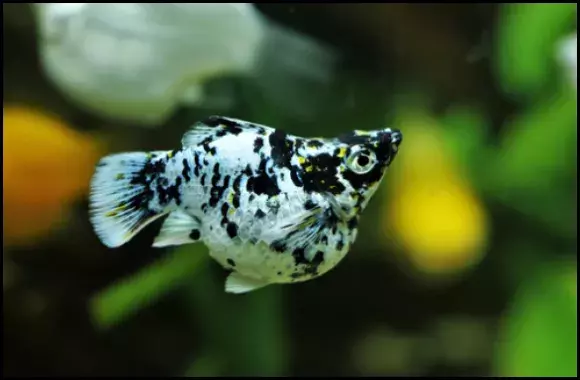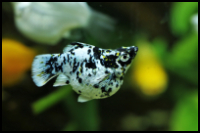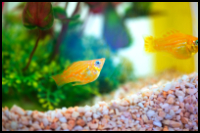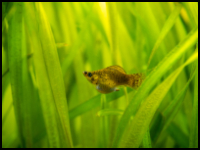




Quick Care Details (Table)
| Livestock Characteristics | Value |
|---|---|
| Care Level | Easy |
| Temperament | Peaceful |
| Diet | Omnivore |
| Maximum Size | 3.5 Inches |
| Minimum Tank Size | 10 Gallons |
| Plant Safe | Yes |
| Temperature Range | 75-82F |
| PH Range | 7.5-8.5 |
| KH Range | 180-450ppm |
| GH Range | 180-450ppm |
Species Specific Categories
Helpful Video
Care Details
Aquascape
- Provide a well-planted aquarium with live or artificial plants to create hiding spots and add aesthetic appeal.
- Include driftwood, rocks, and caves to offer additional hiding places and territories for the fish.
- Balloon mollies appreciate a mix of open swimming areas and shaded spots.
Substrate
- Use a fine-grain substrate to prevent the fish from ingesting large particles while foraging.
- Sand or smooth gravel is ideal for balloon mollies, as they often sift through the substrate looking for food.
Disease Prevention
- Quarantine new fish before introducing them to the main tank to prevent the spread of diseases.
- Maintain good water quality through regular water changes and proper filtration to reduce stress and improve overall health.
- Avoid overfeeding, as uneaten food can lead to water quality issues and stress the fish.
Filtration
- Use a reliable aquarium filter appropriate for the tank size to keep the water clean and free from ammonia and nitrite buildup.
- Consider a filter with mechanical, biological, and chemical filtration capabilities to maintain optimal water conditions.
Lighting
- Provide a moderate lighting level for the aquarium, usually 8-10 hours per day.
- Avoid intense lighting that could stress the fish, especially if the tank is densely planted.
Water Flow
- Balloon mollies prefer a gentle to moderate water flow in the tank.
- Ensure the filter outlet doesn't create strong currents, as excessive flow can stress the fish.
Hardiness
- Balloon mollies are generally hardy and adaptable to various water conditions.
- They can tolerate a wide range of pH levels (around 7.0-8.5) and water hardness (8-30 dGH).
- Keep water temperature between 75-82°F (24-28°C) to match their tropical nature.
Temperament and Behavior
Behavior and Social Interaction
- Balloon mollies are generally peaceful and social fish.
- They are known for their active swimming and curiosity, making them interesting to observe in the aquarium.
- Balloon mollies are shoaling fish, so they tend to thrive in groups of their own kind, but they can be keep solo on their own.
Aggression
- Balloon mollies are not highly aggressive, but occasional chasing and squabbles might occur, especially during breeding or in limited spaces.
- Providing ample hiding spots and space can help minimize aggression.
Breeding
- Balloon mollies are livebearers, which means the female gives birth to live fry instead of laying eggs.
- Breeding is relatively easy in a well-maintained aquarium.
- Pregnant females can be identified by their swollen abdomen, and they may seek out isolated spots to give birth.
Compatibility
- Balloon mollies are generally compatible with peaceful community fish that can tolerate slightly brackish water conditions.
- They can even adapt to saltwater marine environments.
- They can coexist with other livebearers, such as guppies and platies.
- Avoid keeping them with fin-nipping or aggressive fish.
Activity Level
- Balloon mollies are active swimmers that like to explore the tank.
- They enjoy open spaces for swimming, as well as areas with plants and decorations for shelter.
- the will swim mostly in the middle and top areas of the tank.
Clean-up Crew
- Balloon mollies are effective algae eaters and can help keep the tank relatively clean by consuming small bits of food and debris.
- While they can assist in cleaning, they should not be solely relied upon as a clean-up crew.
Diet and Nutrition
Dry Foods
- High-quality dry foods like flakes and pellets are suitable for balloon mollies.
- Look for fish foods specifically formulated for tropical or community fish.
- Ensure the food is appropriate for the size of the fish and can be consumed easily.
Frozen Foods
- Offer frozen foods like brine shrimp, bloodworms, daphnia, and cyclops to provide a varied diet.
- Frozen foods are rich in nutrients and can help enhance the colors of the fish.
Live Foods
- Balloon mollies readily accept live foods, such as brine shrimp, daphnia, and blackworms.
- Live foods can stimulate their natural foraging behaviors and add variety to their diet.
Vegetables
- While balloon mollies are primarily omnivores, they may eat blanched vegetables occasionally.
- Offer small portions of blanched veggies like spinach, zucchini, or peas as a supplementary treat.
Algae
- Balloon mollies will happily graze on soft algae in the tank.
- They will eat large amounts of soft algae if given the opportunity.
Feeding Schedule
- Feed balloon mollies two to three times a day, offering only what they can consume in a few minutes.
- A varied diet is crucial for their health, so rotate between dry, frozen, and live foods.
- Avoid overfeeding, as excess food can lead to water quality issues and health problems.
Tank Parameters
Tank Size
- For a small group of balloon mollies, a tank with a capacity of at least 20-30 gallons is recommended.
- A larger tank provides more stable water conditions and more space for the fish to swim and explore.
- Keep in mind that balloon mollies can produce a significant number of fry, so plan for additional space if you intend to keep the offspring.
Tank Length and Measurements
- A tank with dimensions around 24 inches (60 cm) in length, 12 inches (30 cm) in width, and 16 inches (40 cm) in height can accommodate a small group of balloon mollies.
- For more fish or to create a spacious environment, consider larger tank dimensions.
The Species Maximum Size
- Balloon mollies are relatively small fish. The standard size for adult balloon mollies is around 2.5 to 4 inches (6 to 10 cm) in length.
Water Temperature
- Balloon mollies are tropical fish and prefer a water temperature range of 75-82°F (24-28°C).
- Use an adjustable aquarium heater to maintain a stable temperature within this range.
pH (Acidity/Alkalinity)
- Balloon mollies can tolerate a relatively wide pH range but prefer slightly alkaline water.
- Aim for a pH level between 7.5 and 8.5 to match their natural habitat.
KH (Carbonate Hardness)
- Balloon mollies are adaptable to a range of carbonate hardness levels but prefer slightly hard to moderately hard water.
- Aim for a KH range of 5-20 dKH (degrees of Carbonate Hardness).
GH (General Hardness)
- Balloon mollies can tolerate a broad range of general hardness levels.
- Aim for a GH range of 10-30 dGH (degrees of General Hardness).
Nitrate (NO3) Levels
- Regularly monitor nitrate levels in the tank, as elevated nitrate can harm balloon mollies and other fish.
- Aim to keep nitrate levels below 20-30 ppm (parts per million) through regular water changes and proper filtration.
History, Popularity, History and Species Variety Details
History and Popularity
While the exact origins and specific timeline of their development may not be fully documented, it is believed that Balloon Mollies emerged as a result of selective breeding efforts to create unique and distinctive fish forms.
The Balloon Molly, also known as the Balloon Molly fish, is a selectively bred variant of the common Molly (Poecilia sphenops). Mollies themselves are native to the freshwater habitats of Central and South America, where they have inhabited various river systems and brackish environments for centuries.
Selective breeding for specific traits, such as body shape and size, is a common practice among fish breeders and enthusiasts. Balloon Mollies are the result of such breeding programs, focusing on producing fish with an exaggerated, rounded body shape, hence the name "Balloon."
The development of the Balloon Molly likely involved identifying and selecting individual Mollies with natural genetic variations that exhibited rounder body forms. These individuals were then selectively bred together over multiple generations to accentuate the desired traits.
Over time, through careful selection and breeding, breeders were able to establish a line of Mollies with a distinct balloon-like appearance. The breeding process involved crossing Mollies with naturally rounder body shapes, continuously selecting offspring that exhibited the desired balloon-like traits, and further refining the genetic pool.
While Balloon Mollies were initially created for their unique aesthetic appeal, their popularity has grown steadily among aquarium enthusiasts. The whimsical and playful appearance of these puffy fish has captured the hearts of many hobbyists around the world.
It's important to note that the breeding of Balloon Mollies has also sparked debates within the aquarium community. Critics argue that the balloon-like shape may cause health issues or reduce the fish's swimming capabilities. Consequently, responsible breeders focus on maintaining the overall health and well-being of the fish while preserving the unique balloon form.
As with any selectively bred fish, it's crucial to consider the ethical aspects of breeding and ensure that the fish's welfare remains a top priority. Balloon Belly Mollies should be cared for in suitable aquarium environments, provided with a balanced diet, and monitored for any signs of health concerns.
Acceptable Balloon Molly Environments
Balloon Mollies in Freshwater
- Balloon mollies are well-adapted to life in various freshwater environments, including rivers, streams, and standing water bodies.
- Mollies are most commonly found in freshwater aquarium hobby.
- They are often found in areas with dense aquatic vegetation and submerged plants, as these provide them with hiding spots and food sources.
- Balloon mollies are commonly encountered in warm, tropical climates with temperatures ranging from 75-82°F (24-28°C).
- In the wild, they feed on a variety of food sources, including algae, small insects, crustaceans, and other organic matter.
Balloon Mollies in Brackish Water:
- Brackish water is a mix of freshwater and saltwater, usually found in estuaries and mangrove swamps.
- Balloon mollies can tolerate a slight increase in salinity, but they are best kept in low to moderately brackish conditions (specific gravity of around 1.005 to 1.010).
- In brackish water, balloon mollies may display enhanced colors and activity levels.
- Some aquarists choose to keep balloon mollies in slightly brackish conditions, especially when they want to incorporate marine plants and a brackish water environment in the aquarium.
- It's essential to gradually acclimate balloon mollies to brackish water to avoid shock or stress.
Balloon Mollies in Marine Saltwater:
- Balloon molly fish are mostly seen in freshwater in the aquarium hobby, but they can survive full strength marine saltwater environment.
- acclimation needs to be done extremely slowly. It could take between 24-48 hours of slowly raising the salinity.
- Placing balloon mollies in saltwater would lead to severe stress, dehydration, and ultimately, death if not acclimated correctly.
- Keeping them in a fully marine environment is possible, but the have very little immunity to marine parasites and disease.
Types of Balloon Molly Fish
- Black Balloon Molly: A black color variation with a rounded body shape.
- Gold or Yellow Balloon Molly: A bright gold or yellow color variation with a rounded body shape.
- Dalmatian Balloon Molly: A variation with a white body and black spots, resembling a Dalmatian dog.
- Marble Balloon Molly: A variation with a marbled pattern, featuring a mix of different colors on the body.
- Lyretail Balloon Molly: A variation with an elongated and lyre-shaped tail fin, combined with the balloon body shape.
- Sailfin Balloon Molly: A variation with an extended and sail-like dorsal fin, in addition to the balloon body shape.
- Veiltail Balloon Molly: A variation with long, flowing fins, including the dorsal, anal, and caudal fins.
Understand The Differences of Mollies Gender
Male Balloon Mollies
- Gonopodium: The most significant and distinguishing feature of male balloon mollies is their gonopodium, a modified anal fin that is elongated and pointed. It is used for mating and is absent in female mollies.
- Fin Size: Males typically have larger and more colorful dorsal (top) and anal (bottom) fins compared to females.
- Slimmer Body: In general, male balloon mollies tend to have a slimmer body shape than females.
- Chasing Behavior: Males may display chasing behavior towards females during mating attempts.
Female Balloon Mollies
- Larger Size: Female balloon mollies are usually larger and more rounded than males.
- Anal Fin: Females have a rounded anal fin without the elongated and pointed shape of the male's gonopodium.
- Broader Body: Females often have a broader and more rounded abdomen due to their ability to carry and give birth to fry.
Breeding Balloon Mollies
1. Set Up a Breeding Tank
- Prepare a separate breeding tank of about 10-20 gallons in size. This will provide a controlled environment for breeding and protect the fry from adult fish.
2. Provide Suitable Environment
- Ensure the breeding tank has a temperature of around 75-82°F (24-28°C) and a pH level between 7.5 and 8.5, which mimics their natural habitat.
- Include plenty of live or artificial plants for hiding spots and to give the female a place to give birth.
3. Introduce a Breeding Pair
- Choose a healthy male and female balloon molly to be your breeding pair. Make sure they are in good condition and free from any signs of illness.
4. Condition the Fish
- Provide the breeding pair with a varied and nutritious diet to prepare them for breeding. Offer high-quality foods like live or frozen brine shrimp, daphnia, and bloodworms.
5. Observe Courting Behavior
- Balloon mollies will engage in courtship behavior, with the male actively pursuing the female and performing displays to attract her.
6. Monitor Female for Pregnancy
- After successful mating, the female will become pregnant, and her abdomen will swell as the fry develop.
7. Separate Female Before Birth
- As the female's pregnancy progresses, monitor her closely, and once she displays signs of imminent birth (a squared-off appearance and dark gravid spot near the anal fin), transfer her to the breeding tank to give birth.
8. Allow the Female to Give Birth
- Once the female is in the breeding tank, provide her with plenty of hiding spots and plants where she can release her fry.
- Balloon mollies are livebearers, and the female will give birth to fully formed fry. The fry will be able to swim and should be left in the breeding tank.
9. Remove Adult Fish
- Once the female has given birth, remove her from the breeding tank to prevent her from consuming the fry.
10. Provide Fry with Proper Care
- The fry are initially tiny and can be fed with infusoria or commercially available fry food.
- As they grow, introduce powdered or crushed flakes to their diet.
- For proper molly care keep the water quality pristine, perform regular water changes, and provide suitable hiding spots for the fry to grow safely.
Common Risk of Diseases For Balloon Mollies
-
Ich (Ichthyophthirius multifiliis)
- Ich is a common parasitic disease that appears as white spots on the fish's body and fins. It can be caused by stress, poor water conditions, or introducing infected fish to the tank.
-
Fin Rot
- Fin rot is a bacterial infection that leads to the deterioration of the fish's fins. It can be caused by poor water quality, injury, or stress.
-
Velvet (Oodinium)
- Velvet is a parasitic disease that appears as a fine, yellowish-gold dust on the fish's body. Infected fish may also exhibit rapid breathing and flashing behavior.
-
Columnaris (Cotton Wool Disease)
- Columnaris is a bacterial infection that appears as white, cotton-like patches on the fish's body and fins. It can be triggered by poor water conditions and stress.
-
Swim Bladder Disorder
- Balloon mollies, particularly those with exaggerated body shapes, can be more prone to swim bladder disorders due to their altered anatomy.
-
Parasitic Worms
- Various types of parasitic worms can infect balloon mollies and cause health issues.
Frequently Asked Questions
What is the difference between a Balloon Molly and a regular Molly?
The main difference is the body shape. Balloon Mollies have a rounder, more inflated appearance due to a genetic mutation that affects their body structure. Regular Mollies have a more streamlined body shape.
Are Balloon Mollies suitable for beginners?
Yes, Balloon Mollies are generally considered suitable for beginners. They are hardy, adaptable, and relatively easy to care for.
How many Balloon Mollies should I keep together?
You can keep a single Ballon Molly, but they are social fish and thrive in groups. It is recommended to keep them in a small school of at least three to five individuals.
Can Balloon Mollies live with other fish species?
Yes, Balloon Mollies are generally peaceful and can live with other peaceful community fish that share similar water requirements. Avoid keeping them with aggressive or fin-nipping fish species.
How long do Balloon Mollies live?
On average, Balloon Mollies have a lifespan of 3 to 5 years. With proper care and a suitable environment, they may live longer.
Can Balloon Mollies be kept in a freshwater or saltwater tank?
Balloon Mollies are mostly seen in freshwater aquariums, but can be keep in brackish or saltwater aquariums.
Do Balloon Mollies require a heater in their tank?
Yes, Balloon Mollies are tropical fish and require a heater to maintain a consistent water temperature between 75°F and 82°F (24°C and 28°C).
Can I keep only male Balloon Mollies together?
Keeping only male Balloon Mollies together is generally not recommended. Male Mollies can display territorial behavior and may become aggressive towards each other. It's best to maintain a balanced ratio of males to females.
How can I tell if my Balloon Molly is pregnant?
Pregnant female Balloon Mollies have a swollen abdomen, and you may notice a dark triangular spot called a "gravid spot" near the rear vent. The spot will darken as the pregnancy progresses.
What should I feed my Balloon Mollies?
Balloon Mollies are omnivorous. A balanced diet can include high-quality flakes or pellets, supplemented with live or frozen foods such as brine shrimp, bloodworms, or daphnia. Vegetation, such as algae-based foods or blanched vegetables, can also be included in their diet.

